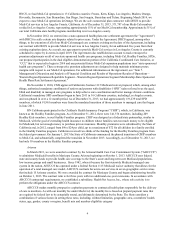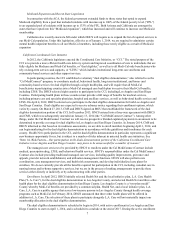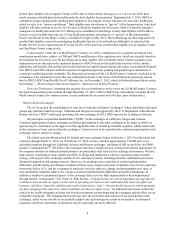Health Net 2013 Annual Report Download - page 18
Download and view the complete annual report
Please find page 18 of the 2013 Health Net annual report below. You can navigate through the pages in the report by either clicking on the pages listed below, or by using the keyword search tool below to find specific information within the annual report.16
Arizona HMO's commercial lines of business received NCQA accreditation with a score of “commendable.”HN
California’s Medi-Cal line of business holds an “accredited” rank from the NCQA. Our MHN subsidiary has received
URAC accreditation.
Government Regulation
Our business is subject to comprehensive federal regulation and state regulation in the jurisdictions in which we
do business. These laws and regulations govern how we conduct our businesses and result in additional requirements,
restrictions and costs to us. Certain of these laws and regulations are discussed below.
New laws and regulations, or changes in the interpretation of existing laws and regulations, including as a result
of changes in the political climate, could have an adverse effect on us. In the event we fail to comply with, or fail to
respond quickly and appropriately to changes in, applicable law and regulations, our business, results of operations,
financial condition and cash flows could be materially and adversely affected. For additional information, see “Item 1A.
Risk Factors—Our businesses are subject to laws and significant rules and regulations, which increases our cost of
doing business and could impact our financial performance by restricting our ability to conduct business or adversely
affecting our ability to grow our businesses” and “Item 1A. Risk Factors—Federal and state audits, reviews and
investigations of us and our subsidiaries could have a material adverse effect on our operations, financial condition
and cash flows.”
Health Care Reform Legislation and Implementation
The ACA transformed the U.S. health care system through a series of complex initiatives. The measures initiated
by the ACA and the associated preparation and implementation of these measures have had, and will continue to have
an adverse impact on our revenues and the costs of operating our business and could materially adversely affect our
business, cash flows, financial condition and results of operations. Due in part to the scope and complexity of these
initiatives, as well as their ongoing implementation, the ultimate impact of the ACA on us remains difficult to predict.
• The ACA imposes significant fees, assessments and taxes on us and other health insurers, health plans and
industry participants. Among others, the ACA imposes a significant non-deductible tax (technically called
a “fee”) on health insurers, effective for calendar years beginning after December 31, 2013. This “health
insurer fee” will be $8 billion nationwide in 2014 assessed on all non-exempt premium revenue on a pro
rata basis and payable in 2014 unless extended pursuant to a bipartisan bill introduced in the House of
Representatives in October 2013. Insurers with exempt premium revenues (e.g., non-profit business) may
be assessed at a lower rate. The health insurer fee will increase after 2014 and will be assessed on the
amount of net premiums written during the previous calendar year, subject to certain exceptions.
• The ACA also requires the establishment of state-run or federally facilitated “exchanges” where
individuals and small groups may purchase health coverage. We are participating as QHPs in the currently
operating exchanges in California, Oregon and Arizona, with the initial open enrollment periods beginning
on October 1, 2013 and continuing through March 31, 2014. For further information on these exchanges,
see the discussion above under the heading “—Segment Information—Western Region Operations
Segment—Western Region Exchanges”.
• The ACA also contains premium stabilization provisions designed to apportion risk amongst insurers.
These stabilization provisions include a permanent risk adjustment provisions applicable to the individual
and small group markets that became effective at the beginning of 2014 and will shape the economics of
health care coverage both within and outside the exchanges. These risk adjustment provisions will
effectively transfer funds from health plans with relatively lower risk enrollees to plans with relatively
higher risk enrollees to help protect against the consequences of adverse selection. The individual and
small group markets are expected to represent a significant portion of our commercial business and the
relevant amounts transferred may be substantial. To adapt to this new economic framework, we have
dedicated significant resources and incurred significant general and administrative costs to implement
numerous strategic and operational initiatives both within and outside the exchanges that, among other
things, require us to focus on and manage different populations of potential members than we have in the
past.
• Other premium stabilization provisions include the temporary reinsurance and risk corridors programs,
which seek to ease the transition into the post-ACA market by helping to stabilize rates and protect against
rate uncertainty in the initial years of the ACA. The final determination and settlement of amounts due or
payable from these premium stabilization provisions will not occur until 2015, and there is no assurance
























